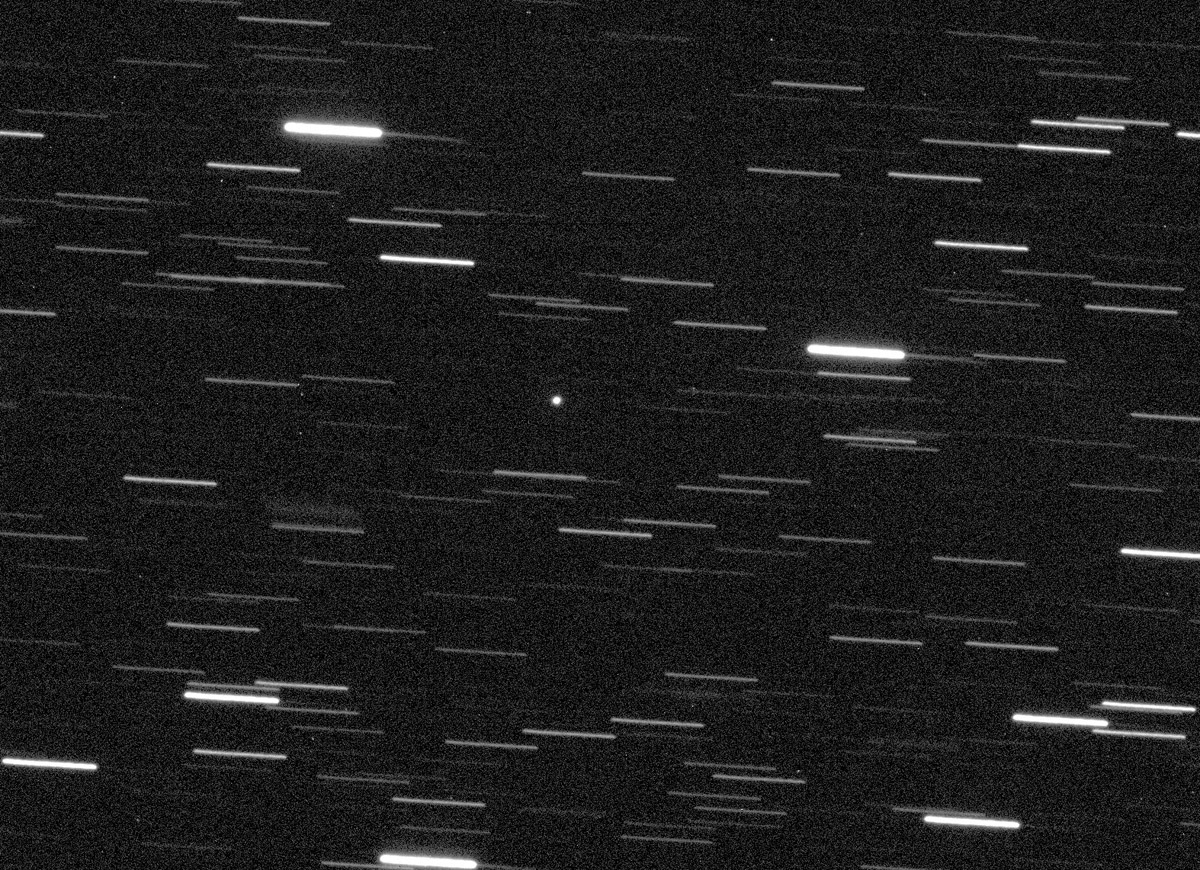

WEEK 45: NOVEMBER 1-7
TOPIC: THE DEATH OF COMETS
What happens to comets when they “die?” Our solar system has been around for 4.6 billion years, and, obviously, a large percentage of the comets that the solar system started off with are no longer with us. While many comets still remain in the reservoirs of the outer solar system, i.e., the Kuiper Belt and the Oort Cloud, once they begin making passages into the inner solar system and start becoming active their days, so to speak, are numbered. As it turns out, there are several mechanisms by which comets can meet their demise.
Many comets do not “die” but rather are ejected from the solar system and thus “exiled” into interstellar space. As discussed in previous “Special Topics” presentations, the comets that were initially kicked out into the Oort Cloud are only loosely held to the solar system, and passing stars and tidal forces from the overall Galaxy can either perturb comets into the inner solar system or eject them from the solar system completely, and it is likely that there are far more of the latter than there are of the former. Comets that pass by the major planets, especially Jupiter, can also be perturbed into hyperbolic orbits and consequently ejected from the solar system, and this has in fact been observed on numerous occasions.
Any such exiled comet would roam through the Galaxy essentially forever. On occasion, such as with the interstellar Comet 2I/Borisov last year – a previous “Comet of the Week” – it might encounter another planetary system and pass through it, but after doing so it would once again head back out into the Galaxy and continue its wanderings.
Some comets will meet a much more dramatic demise by impacting another object, and this has undoubtedly occurred many times throughout the solar system’s history. We have seen this once, in July 1994 when Comet Shoemaker-Levy 9 1993e – another previous “Comet of the Week” – impacted Jupiter. Earth has also certainly been impacted by comets from time to time, although hopefully this will not happen anytime within humanity’s near- to intermediate term future, and in the unlikely event that a threatening object were to be inbound the presently-operating survey programs should give us a long enough advance warming to take appropriate action, as discussed in previous “Special Topics” presentations.

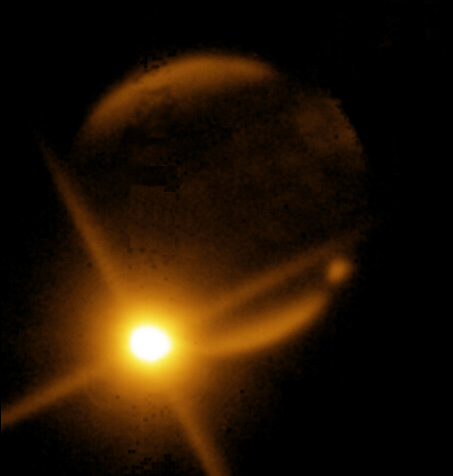
Comets, being made up of various ices, are rather porous objects to begin with, and as they make repeated passages through perihelion they continuously lose a fraction of their material. Eventually, so much material is lost that there is really nothing left, and the comet essentially just “disappears.” Even through the half-century that I have been following comets there have been several periodic comets that have simply vanished and that are no longer making returns.
Sometimes this disintegration process is accompanied by a fragmenting of the nucleus. A classic example of this is Comet 3D/Biela – a previous “Comet of the Week” – which, after being observed during several returns in the late 18th and early 19th Centuries, appeared as a “double comet” for two returns and then just vanished – with the exception of strong meteor showers that occurred for a few returns thereafter. Although not quite as dramatic as this, there have been a couple of more recent cases where a periodic comet has been observed to fragment and then subsequently vanish. Since the fragmenting of a comet’s nucleus will expose previously-hidden ice to sunlight which will then start undergoing new activity, these fragmenting events are often associated with outbursts in brightness. Indeed, there have been a couple of recent cases where a short-period comet was discovered during an obvious outburst, and then disappeared after a few returns – or in a few cases was never seen again.
Many long-period comets also have been seen to disintegrate as they pass through perihelion. In general, the smaller a comet’s perihelion distance – and thus the more intense solar heating it experiences – and the smaller the nucleus, the more likely it is that it will not survive perihelion. The small spacecraft-discovered Kreutz sungrazers – discussed in last week’s “Special Topics” presentation – are a striking example of this. Over my years of observing comets there have been several that have proceeded towards perihelion – sometimes exhibiting outbursts as they do so – but then either didn't reappear after perihelion, or in some cases didn't even make it to perihelion at all. In 1991 veteran comet observer John Bortle developed an empirical formula that utilizes a long-period comet’s perihelion distance and its absolute magnitude to predict whether or not it will survive perihelion: H_max = 7.0 +6q, where H_max is the limiting absolute magnitude for survival (and q, as always, is the perihelion distance in AU). While the exact physical relationship between a comet’s absolute magnitude and the size of its nucleus is not something that can be firmly established, in general, the brighter the absolute magnitude, the larger the nucleus.
A recent dramatic example of a disintegrating long-period comet is Comet ISON C/2012 S1, which is a future “Comet of the Week.” Another interesting recent example is Comet Elenin C/2010 X1, which passed through perihelion in September 2011 at a heliocentric distance of 0.48 AU. As the comet disappeared into twilight en route to perihelion it began to grow very diffuse, as if it was starting to disintegrate, and when it passed through perihelion and theoretically should have been detectable with the coronagraphs aboard the NASA/ESA SOlar and Heliospheric Observatory (SOHO) spacecraft there was nothing to be seen, despite the fact that there should have been a strong brightness enhancement due to forward scattering of sunlight. When Comet Elenin emerged into the morning sky in October initially nothing was seen, however once it climbed higher above the horizon CCD images began to show a thin wisp-like structure 10 to 20 arcminutes long. This was the comet’s tail, apparently created by a dust ejection event just as the nucleus began to disintegrate; it survived, while the comet itself did not.
We have seen some recent examples of this phenomenon during “Ice and Stone 2020.” As discussed in its own “Comet of the Week” Presentation, Comet ATLAS C/2019 Y4 began to disintegrate as it approached perihelion, and as it turned out nothing was seen afterwards. Comet SWAN C/2020 F8, discussed within that same Presentation, also began to show signs of disintegration, and by the time of perihelion passage was nothing more than a “smear” of light that disappeared not too long thereafter.
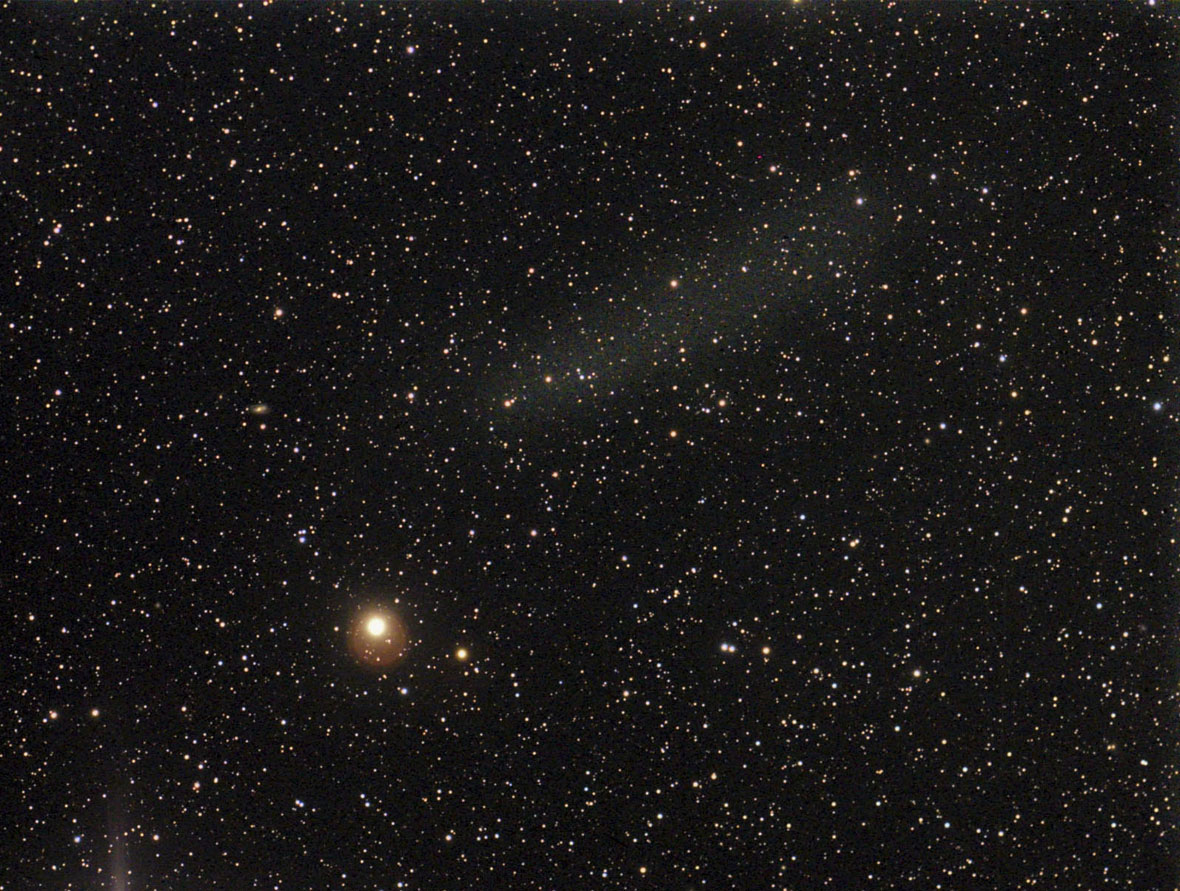
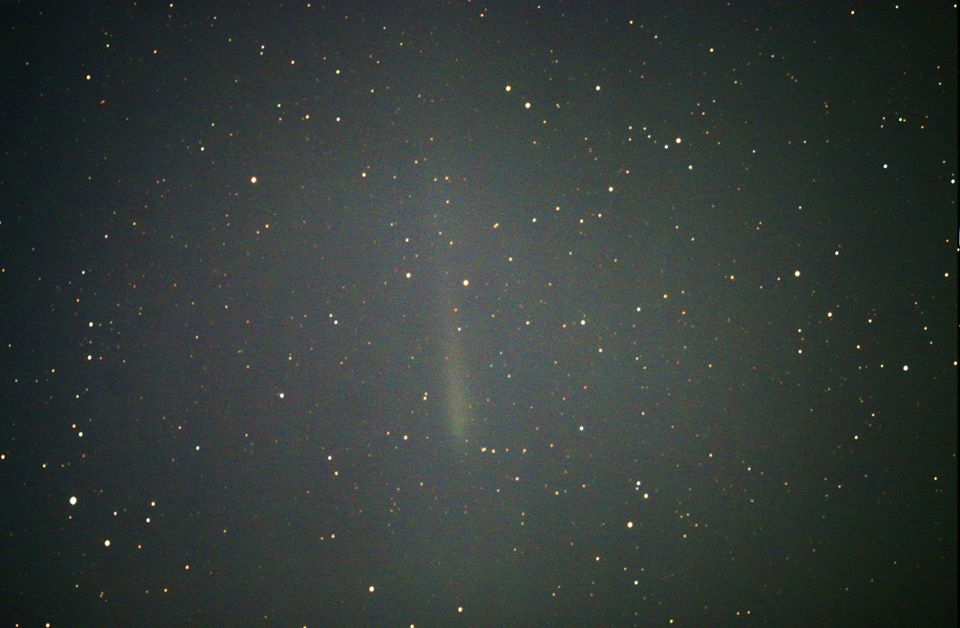 LEFT: The tail remnant of Comet Elenin C/2010 X1 on October 22, 2011, as imaged by a remotely-controlled telescope in New Mexico. Courtesy Rolando Ligustri in Italy. RIGHT: An image of a disintegrating comet: Comet SWAN C/2020 F8 on May 31, 2020, four days after its perihelion passage (heliocentric distance 0.43 AU). Courtesy Pierre Girard in England.
LEFT: The tail remnant of Comet Elenin C/2010 X1 on October 22, 2011, as imaged by a remotely-controlled telescope in New Mexico. Courtesy Rolando Ligustri in Italy. RIGHT: An image of a disintegrating comet: Comet SWAN C/2020 F8 on May 31, 2020, four days after its perihelion passage (heliocentric distance 0.43 AU). Courtesy Pierre Girard in England.
For several periodic comets, especially those with a high dust content, a different fate may be in order. While much of the dust that is ejected from a comet’s nucleus never returns to it, instead continuing to travel around the sun in the comet’s orbit – and, as discussed in a future “Special Topics” presentation, producing meteor showers if that orbit passes close to Earth’s – some of that dust does settle back onto the nucleus. As seen from the “Brownlee particles” – discussed in a previous “Special Topics” presentation – this dust is very dark, and meanwhile over time it coats more and more of the nucleus, until eventually it covers the entire nucleus. The comet at that point “shuts down” and becomes an inert object essentially indistinguishable from an asteroid.
Some of the known periodic comets appear to be “transition” objects on the way from being active comets to becoming “extinct.” The first such known object was Comet 28P/Neujmin 1, discovered in September 1913 by Grigorij Neujmin at the Simeis Observatory in Crimea; despite favorable viewing geometry and passing 0.55 AU from Earth it exhibited at most just a very small coma and a weak short tail no more than a few arcminutes long. It has an orbital period of 18 years and although recovered at all the subsequent returns, for most of those it has appeared entirely asteroidal, although it’s fair to say that the viewing geometry tended to be unfavorable during those returns. During the one somewhat favorable return it has had since then, in 1984, it exhibited at most just a very tiny coma, which was found to be entirely gaseous in content. Studies indicated that the comet’s nucleus is quite large – 21 km in diameter – but that only about 0.1% of its surface area is active.
A handful of additional potential “transition” comets have been discovered during the intervening years, perhaps one of the more notable ones being 49P/Arend-Rigaux. Meanwhile, on October 31, 1920 the German-born astronomer Walter Baade, then working at Hamburg Observatory in Bergedorf, discovered a 13th-magnitude apparent asteroid now known as (944) Hidalgo. This object was found to be traveling in a distinct elliptical and inclined orbit (eccentricity 0.65, inclination 43 degrees) with a period of close to 13.6 years; its perihelion distance is close to 2 AU, but at aphelion it travels out to 9.4 AU, almost as far as Saturn. The story is told that at first Baade was unsure whether to announce his discovery as a comet or as an asteroid, finally deciding upon the latter since he felt its unusual orbit would cause his fellow astronomers to pay closer attention to it.
Hidalgo has been extensively observed and studied at every subsequent return, the most recent of which was in 2018. It has never exhibited any kind of activity that can be considered “cometary,” although it is apparently very dark, as would be expected for an extinct, or dormant, cometary nucleus, and it is apparently quite large, almost 38 km in diameter.
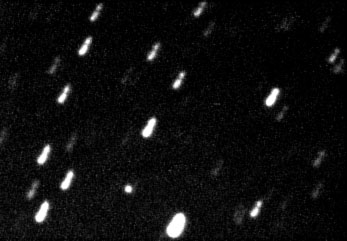
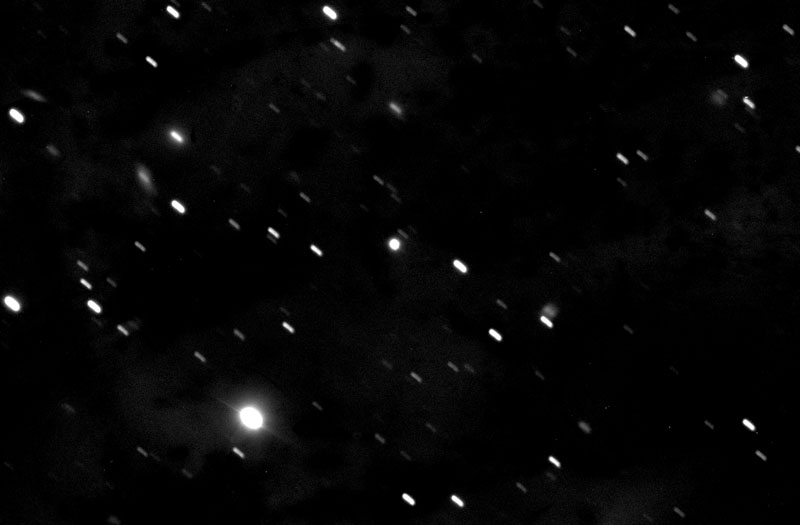 Images I have taken of (944) Hidalgo. Left: CCD image I took on January 13, 2005. Right: Image I took on October 14, 2018 with the 2-meter Las Cumbres Observatory Faulkes Telescope North at Haleakala, Hawaii.
Images I have taken of (944) Hidalgo. Left: CCD image I took on January 13, 2005. Right: Image I took on October 14, 2018 with the 2-meter Las Cumbres Observatory Faulkes Telescope North at Haleakala, Hawaii.
Since Hidalgo’s discovery many additional “asteroids” have been found traveling in cometary orbits, most of these discoveries having come within the past two decades as the comprehensive survey programs have become operational. Since they do not exhibit cometary activity they are not as easy to detect as are active comets, but their population must nevertheless be quite large, and in fact in a 1994 paper planetary geologist Eugene Shoemaker and his colleagues estimated that, for every active Jupiter-family periodic comet, there may be as many as 18 or more inactive, or “extinct” such comets. At least some of these objects may be in shorter-period orbits like those of the Amor- and Apollo-type asteroids, and in fact in a 2008 paper Francesca DeMeo and Richard Binzel at MIT suggested that approximately 8% of the near-Earth “asteroid” population has a cometary origin. One recent and very interesting such object is 2015 TB145, discovered by the Pan-STARRS survey program in Hawaii, which passed just 1.3 lunar distances from Earth on October 31, 2015; it travels in a highly-elongated orbit (eccentricity 0.86) with a period of three years, and is very dark as a cometary nucleus would be expected to be.
Occasionally one of these cometary “asteroids” is found to be exhibiting cometary activity at a very low level, indicating that they are not entirely “extinct” yet. A dramatic example is (3552) Don Quixote, discovered in 1983 by Paul Wild at Berne University in Switzerland; it travels in an elongated orbit (eccentricity 0.71) with an orbital period of slightly under nine years. It had been recovered at every return since its discovery and had never exhibited cometary activity, until in 2013 when a team led by Michael Mommert (now at Northern Arizona University) announced that, in infrared data taken with the Spitzer Space Telescope during its return in 2009, Don Quixote exhibited a distinct coma and a faint tail roughly two arcminutes long. The Spitzer data is entirely consistent with sublimation of carbon dioxide and/or carbon monoxide, indicating that Don Quixote is indeed still exhibiting weak cometary activity. Meanwhile, during Don Quixote’s most recent return in 2018 Mommert’s team detected a faint coma and a tail at optical wavelengths.
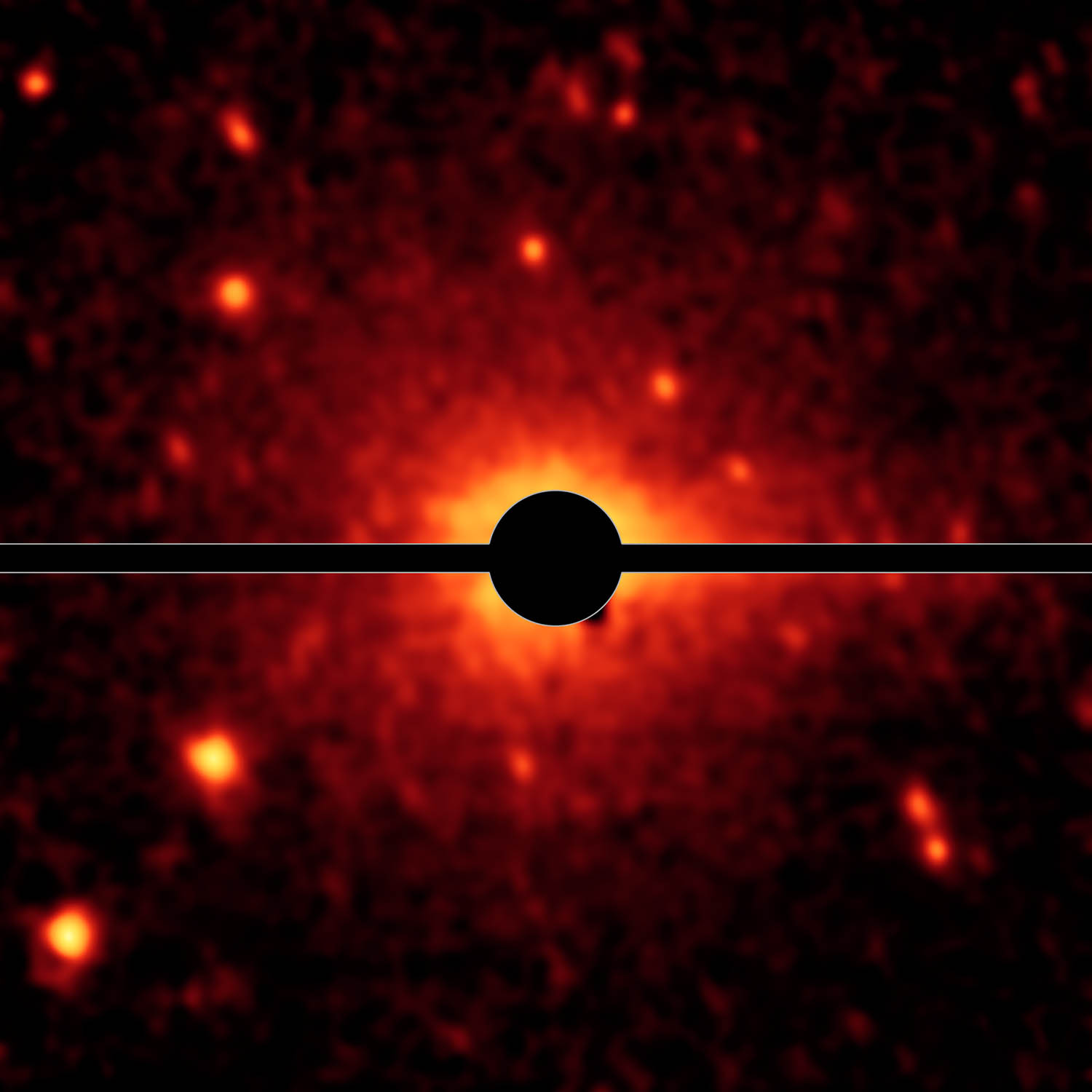
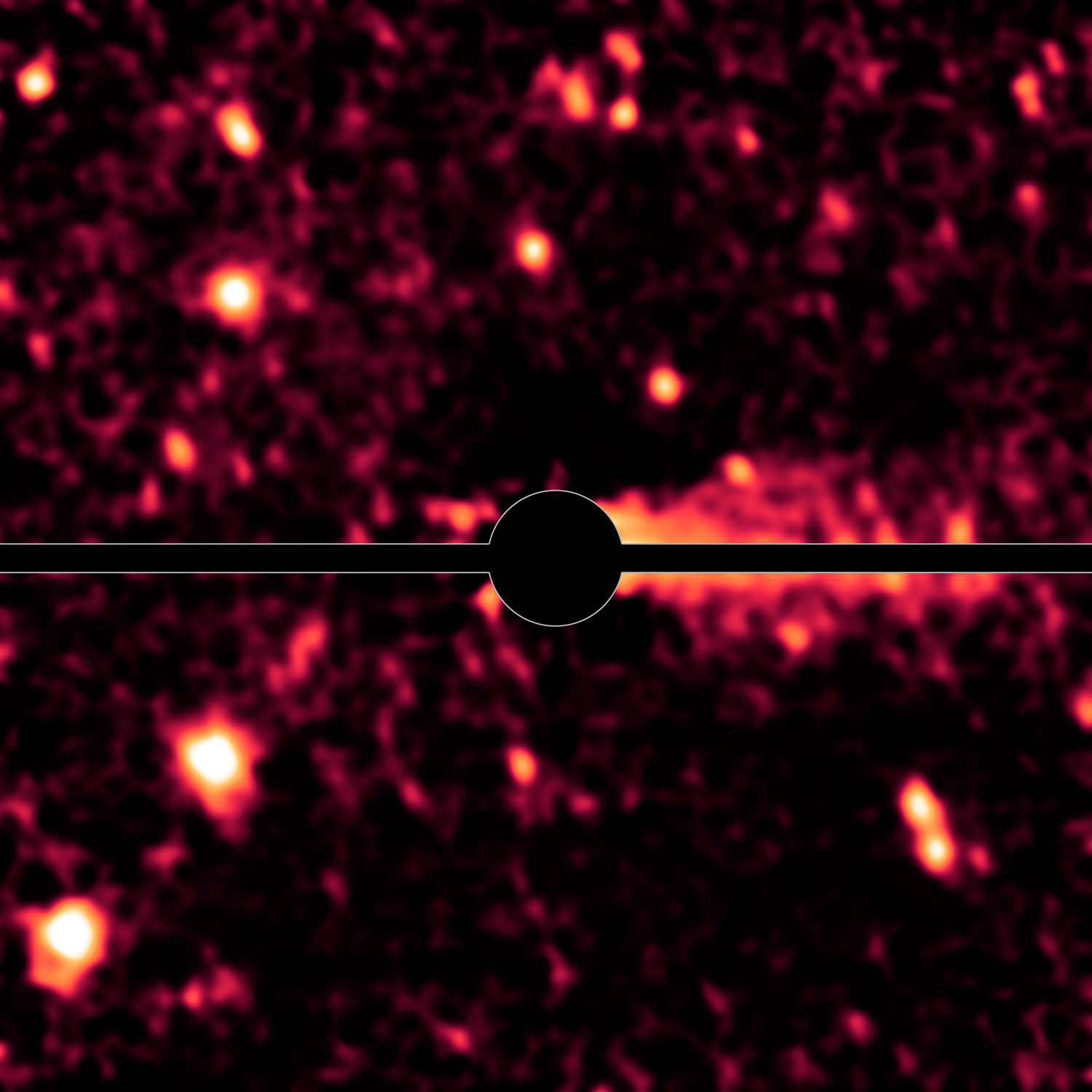 Infrared images of (3552) Don Quixote obtained with the Spitzer Space Telescope on August 22, 2009. Left: The stellar central condensation has been subtracted out, revealing the faint surrounding coma. Right: The coma has been subtracted out, revealing a faint tail. Images courtesy NASA/JPL-CalTech/ DLR/NAU.
Infrared images of (3552) Don Quixote obtained with the Spitzer Space Telescope on August 22, 2009. Left: The stellar central condensation has been subtracted out, revealing the faint surrounding coma. Right: The coma has been subtracted out, revealing a faint tail. Images courtesy NASA/JPL-CalTech/ DLR/NAU.
From an astronomical point of view, Halley-type comets, and even long-period comets, can also be considered as “periodic” comets, and thus a similar fate may await some of these objects as well. In February 1991 Rob McNaught at Siding Spring Observatory in New South Wales discovered the apparent asteroid now known as (5335) Damocles, which is traveling in a highly eccentric inclined orbit (eccentricity 0.87, inclination 62 degrees) with an orbital period of 41 years; despite intense scrutiny it was never seen to exhibit cometary activity. Then, in August 1996 the NEAT survey program in Hawaii discovered the apparent asteroid 1996 PW, which was found to be traveling in an almost parabolic orbit (eccentricity 0.99) with an approximate orbital period of 5600 years. It, too, never exhibited any cometary activity.
Despite all the ways that a comet can “die” and the large numbers of comets that have undoubtedly vanished over the lifetime of the solar system, the fact that, even now, 4.6 billion years after the solar system formed, there still are as many comets as there are suggests that we will continue to see comets in our skies for as long as there are humans here to observe them. I have certainly found them to be fascinating objects to watch and study, and I hope that at least a few “Ice and Stone 2020” participants will do so as well.
“Special Topics” archive
Ice and Stone 2020 home page
Earthrise Institute home page
